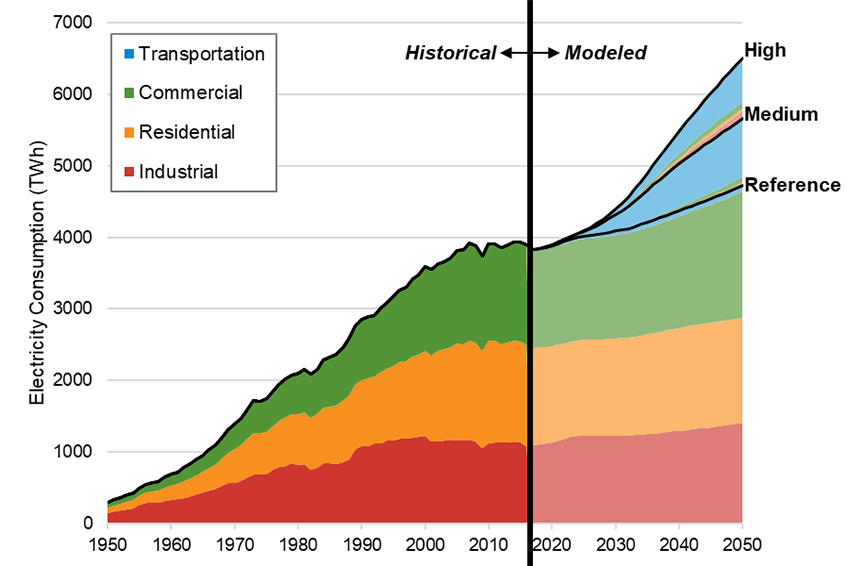NREL Analysis Explores Demand-Side Impacts of a Highly Electrified Future
Second report in the Electrification Futures Study series presents scenarios reflecting a wide range of possible electricity demand growth through 2050 driven by the adoption of end-use electric technologies
The U.S. Department of Energy’s National Renewable Energy Laboratory (NREL) has released the latest analysis from the Electrification Futures Study (EFS), a multi-year research collaboration to explore the impacts of widespread electrification in all U.S. economic sectors—commercial and residential buildings, transportation, and industry.

Historical and projected annual electricity consumption for the report's demand-side adoption scenarios
The report, Electrification Futures Study: Scenarios of Electric Technology Adoption and Power Consumption for the United States, aims to support an integrated understanding of how the potential for electrification might impact the demand side of the U.S. energy system. The report characterizes futures with widespread electrification—the shift from any non-electric source of energy to electricity at the point of final consumption—and quantifies the impacts of electrification on amount and shape of electricity demand.
A Deep Dive into the Demand Side
The report presents three plausible scenarios that reflect varying speed and extent of consumer adoption of end-use electric technologies across all sectors from today through 2050. For each adoption scenario, three scenarios explore the rate of improvement of key electric technologies from a cost and performance perspective, using projections from the first EFS report.
“By exploring the impact of electrification on how much, when and where electricity is used, the demand-side scenarios presented here lay the foundation for future reports on the U.S. power system evolution and operations, as well as key costs and impacts of electrification,” said NREL’s Trieu Mai, principal investigator for EFS. “Our results can also be used by other researchers looking to explore what electrification and demand growth could mean for the U.S. economy.”
The scenarios were developed using a combination of expert judgment based on current trends and insights from the literature, a consumer choice model for light-duty vehicles, and EnergyPATHWAYS, a bottom-up stock-taking tool of all infrastructure that consumes, produces, delivers, or converts energy. They capture a broad uncertainty range and span a considerable range of plausible futures, but should not be interpreted as forecasts or predictions.
What NREL Found
Key findings from the demand-side scenario analysis include:
Electrification could significantly increase overall demand for electricity.
- Widespread electrification increases 2050 U.S. electricity consumption by 20% and 38% in the medium and high adoption scenarios, respectively and relative to the reference.
- On the high end, compound annual growth rates are found to be 1.6%, which are within historical experiences but depart from recent flat growth trends and amount to an unprecedented sustained absolute growth of 80 terawatt-hours per year.
The transportation sector experiences the greatest technology transition toward electrification in the scenarios from this study.
- In the high scenario, electric vehicles would account for up to 76% of vehicle miles traveled in 2050.
- The buildings and industrial sectors generally see less potential for transformational change nationwide, but their electrification could acutely affect certain regions and end uses.
Electrification could dramatically shift load shapes, particularly due to increased adoption of electric heat pumps for winter space and water heating needs.
- This shift in peak demand timing could have significant impacts on electric utility planning, grid operations, reliability assessments, and electricity markets.
- The greatest shifts in peak demand are found in Northeast and Midwest states.
Widespread end-use electric technology adoption would result in substantial shifts in electricity and total energy consumption.
- Electricity share of total final energy consumption grows to 32% in the medium and 41% in the high scenario—significantly above 23% in the reference and 19% in 2016. This growth in electricity share leads to reductions of on-site fossil fuel use; however, incremental fossil fuels could be used for power generation or exports, as will be assessed in future EFS reports.
- The high energy efficiency of advanced electric technologies results in 13% and 21% lower 2050 final energy consumption in the medium and high scenarios, respectively and relative to the reference.
“Looking forward, further research is needed to more comprehensively assess the drivers and impacts of electrification, as well as the role and value of demand-side flexibility,” Mai said. “Although we extensively and qualitatively discuss the potential drivers and barriers behind electric technology adoption in the report, much more work is needed to quantitatively understand these factors. The EFS takes a first step toward answering these complex research questions.”
Download the full report for complete details on the study methodology, assumptions, limitations, and recommendations for further analysis. Scenario data, including state-level equipment stock and energy use data, will also be available for download via the NREL Data Catalog.
Informational Webinar July 26

The NREL study team will host a webinar summarizing the report scenarios, sector projections, key findings, and overall study progress on Thursday, July 26, 2018, from 10 a.m. to 11 a.m. Mountain Time. Register for the free webinar.
Learn More
For more information on the Electrification Futures Study and data sets, visit www.nrel.gov/efs.
Last Updated May 28, 2025
